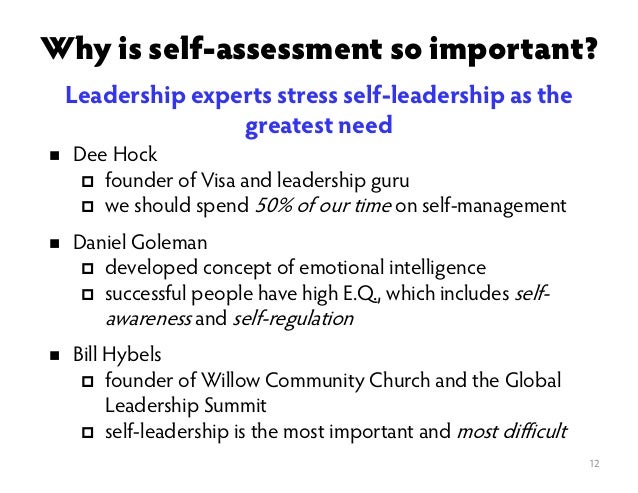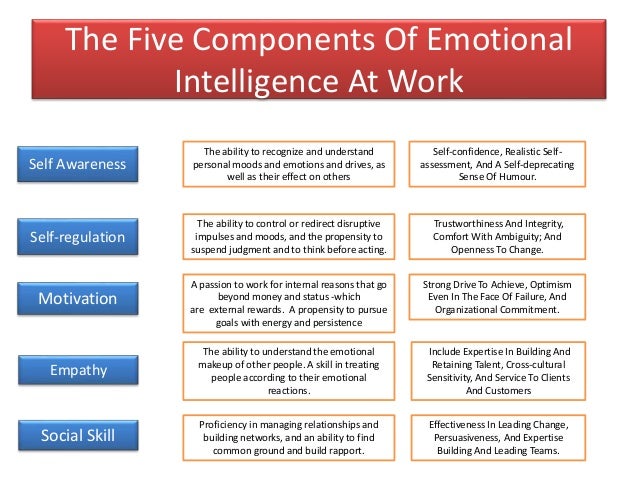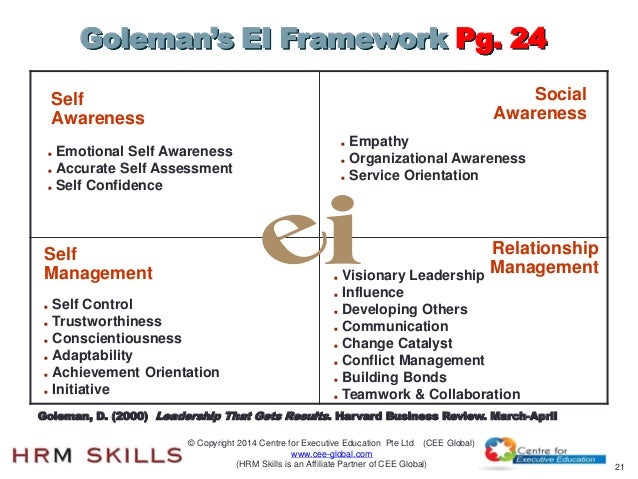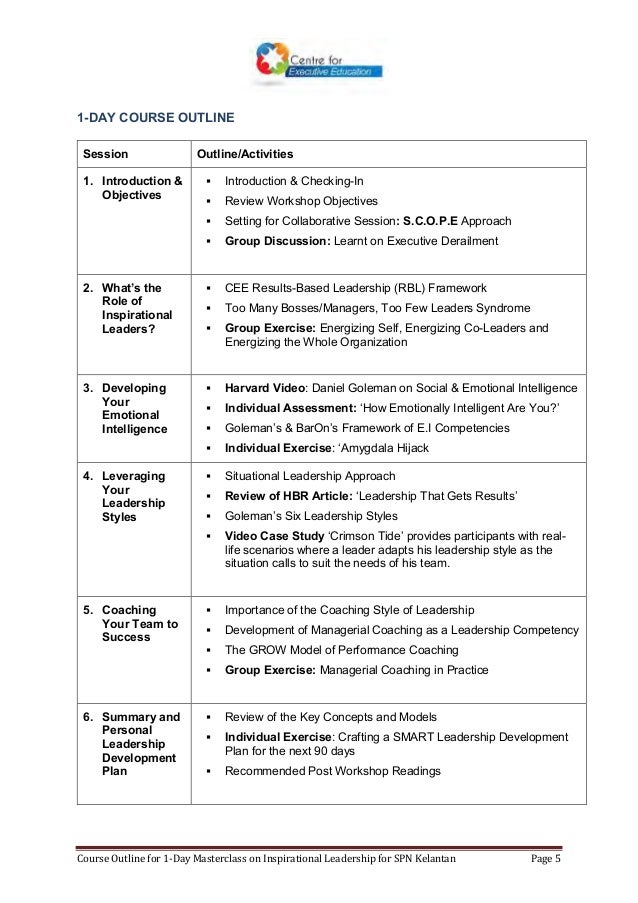Goleman leader types self assessment pdf
Correct self-assessment: One step further reveals that some types of leadership, especially transformational leadership, should actually be a process to foster creativity to enable the
Our quick self-assessment tool will shed light on your strengths and the areas you should focus on. By the end, you will have practical steps and expert advice to hone your management and leadership skills.
awareness and its representative competencies of accurate self-assessment and self-confidence help emotionally intelligent decision-makers to determine their appropriate role in the decision-making process (Goleman, 2001;
a leader provides direction to his or her organization, how plans and programs get implemented, and how staff are motivated to do their work. The first model describes McGregor’s distinction between two main leadership styles, referred to as Theory X and Theory Y. It then discusses another way of categorizing leader-ship styles, based on the Leadership Grid, and explores the view that a
Goleman is a science journalist who brought “emotional intelligence” on the bestseller list and has authored a number of books on the subject, including “Emotional Intelligence,” “Working With Emotional Intelligence,” and, lately, of “Social Intelligence: The New Science of Human Relationships.”
Leader?’, Goleman (1998) states that the five components of Emotional Intelligence at Work are: Self-Awareness, Self-Regulation (or Management), Motivation, Empathy (Social Awareness), and Social Skills (Relationship Management).There is growing evidence that the range of
Self-awareness is therefore a key to being a more effective leader. There is a hierarchy of self-knowledge that a manager or leader might like to follow to commence on the path to self-awareness.
Since the leader’s emotional competencies have an overwhelming influence on the climate of the company, on the motivation of employees, customer relationships, and these skills can be improved, it can be concluded that the development of models of emotional intelligence, the detailing of emotional competencies, of how they can be self-inducted and shaped and the preparation of assessment …
The leader believes in the vision; and sees it as being in tune with his / her own values and those of the organisation. The leader is self-confident, self-aware and empathic to others.
allocate to each style to the “Self-Assessment Report”. I. Assessing dominant and least dominant leadership style(s) Read through the leadership style descriptions on the next page.
This research examines the relationships among leader self-concept based dispositional attributes (i.e., self-consciousness, self-monitoring, and purpose-in-life) with ratings of charismatic leadership.
The coaching leader shows high levels of empathy, self-awareness and skills in developing others. A coaching style is especially useful when an organisation values long-term staff development. A coaching style is especially useful when an organisation values long-term staff development.
Self-concept based aspects of the charismatic leader More

Goleman’s ET Sonoma State University
follows comes from Working with Emotional Intelligence by Daniel Goleman (Bantam, 1998). Personal Competence SELF – AWARENESS Emotional awareness: Recognizing one™s emotions and their effects. People with this competence: • Know which emotions they are feeling and why • Realize the links between their feelings and what they think, do, and say • Recognize how their feelings affect …
The self-assessment results are 100 percent private, visible only to you. We do not collect any information about you and have no way of seeing your results. We do not collect any information about you and have no way of seeing your results.
5 Types of Emotional Intelligence Self-awareness •Self-awareness – ability to read and understand your emotions as well as recognize their impact on work performance, relationships, etc •Accurate self-assessment – realistic evaluation of your strengths and limitations •Self-confidence – strong and positive sense of self-worth. 5 Types of Emotional Intelligence Self-regulation •Self

Can the concept of emotional intelligence enhance a leader’s sense of self and others, and thereby contributing into improving communications at the management level of organizations, and hence develop and amplify workplace performance in themselves, and
The most widely used and widely researched measure of self-report or self-schema (as it is currently referred to) emotional intelligence is the EQ-i 2.0. Originally known as the BarOn EQ-i, it was the first self-report measure of emotional intelligence available, the only measure predating Goleman…
Pacesetting leaders expect excellence and self-direction. Goleman details the types of business situations each style is best suited for, and he explains how leaders who lack one or more
Goleman@iavanet.com. ARTWORK BY CRAIG FRAZIER 93. WHAT MAKES A LEADER? types of leadership. Most mergers need a sensitive negotiator at the helm, whereas many turnarounds require a more forceful authority. I haye found, however, that the most effective leaders are alike in one crucial way: they all have a high degree of what has come to he known as emo-tional intelligence. It’s not …
In the following pages, we’ll explore these questions, taking each of the components of emotional intelligence—self-awareness, self-regulation, motivation, empathy, and social skill—in turn. For the full article please see here Daniel Goleman What makes a leader article R0401H-PDF-ENG
You may be a leader going through a difficult patch, or you may want to lead but doubt your ability and self-confidence to do so. It might be helpful to get a reminder of your strengths and weaknesses as a leader, or to find out if you do have the skills to lead.
After thoughtful reflection, a self-regulated leader would bring the team back together, discuss the consequences of the presentation, and provide his objective assessment of it. He would then offer a well-considered solution.
Leadership style assessment tool e.i. 8,048 views. Share; Like Nirankar Royal and self-restraint to keep from meddling with them while they do it.Leadership skills are the vehicle through which you employ resources to realize a particularoutcome. So, even though you may have a vision or goal, if you dont have the skills torealize it, the vision becomes useless.Leadership skills require
This self-assessment is designed to give you a brief indication of your EI and therefore build self-awareness. It will help you identify your strengths, and identify competencies

(PDF) EMOTIONAL INTELLIGENCE AND LEADERSHIP
– the leader phrase book pdf download
Six Leadership Styles by Daniel Goleman MBA Knowledge Base
The Emotional Competence Framework Businessballs




–


Self-concept based aspects of the charismatic leader More
Six Leadership Styles by Daniel Goleman MBA Knowledge Base
Can the concept of emotional intelligence enhance a leader’s sense of self and others, and thereby contributing into improving communications at the management level of organizations, and hence develop and amplify workplace performance in themselves, and
Self-awareness is therefore a key to being a more effective leader. There is a hierarchy of self-knowledge that a manager or leader might like to follow to commence on the path to self-awareness.
Leader?’, Goleman (1998) states that the five components of Emotional Intelligence at Work are: Self-Awareness, Self-Regulation (or Management), Motivation, Empathy (Social Awareness), and Social Skills (Relationship Management).There is growing evidence that the range of
Pacesetting leaders expect excellence and self-direction. Goleman details the types of business situations each style is best suited for, and he explains how leaders who lack one or more
Our quick self-assessment tool will shed light on your strengths and the areas you should focus on. By the end, you will have practical steps and expert advice to hone your management and leadership skills.
Correct self-assessment: One step further reveals that some types of leadership, especially transformational leadership, should actually be a process to foster creativity to enable the
The most widely used and widely researched measure of self-report or self-schema (as it is currently referred to) emotional intelligence is the EQ-i 2.0. Originally known as the BarOn EQ-i, it was the first self-report measure of emotional intelligence available, the only measure predating Goleman…
This research examines the relationships among leader self-concept based dispositional attributes (i.e., self-consciousness, self-monitoring, and purpose-in-life) with ratings of charismatic leadership.
The self-assessment results are 100 percent private, visible only to you. We do not collect any information about you and have no way of seeing your results. We do not collect any information about you and have no way of seeing your results.
allocate to each style to the “Self-Assessment Report”. I. Assessing dominant and least dominant leadership style(s) Read through the leadership style descriptions on the next page.
follows comes from Working with Emotional Intelligence by Daniel Goleman (Bantam, 1998). Personal Competence SELF – AWARENESS Emotional awareness: Recognizing one™s emotions and their effects. People with this competence: • Know which emotions they are feeling and why • Realize the links between their feelings and what they think, do, and say • Recognize how their feelings affect …
The coaching leader shows high levels of empathy, self-awareness and skills in developing others. A coaching style is especially useful when an organisation values long-term staff development. A coaching style is especially useful when an organisation values long-term staff development.
In the following pages, we’ll explore these questions, taking each of the components of emotional intelligence—self-awareness, self-regulation, motivation, empathy, and social skill—in turn. For the full article please see here Daniel Goleman What makes a leader article R0401H-PDF-ENG
After thoughtful reflection, a self-regulated leader would bring the team back together, discuss the consequences of the presentation, and provide his objective assessment of it. He would then offer a well-considered solution.
Self-concept based aspects of the charismatic leader More
(PDF) EMOTIONAL INTELLIGENCE AND LEADERSHIP
The leader believes in the vision; and sees it as being in tune with his / her own values and those of the organisation. The leader is self-confident, self-aware and empathic to others.
follows comes from Working with Emotional Intelligence by Daniel Goleman (Bantam, 1998). Personal Competence SELF – AWARENESS Emotional awareness: Recognizing one™s emotions and their effects. People with this competence: • Know which emotions they are feeling and why • Realize the links between their feelings and what they think, do, and say • Recognize how their feelings affect …
allocate to each style to the “Self-Assessment Report”. I. Assessing dominant and least dominant leadership style(s) Read through the leadership style descriptions on the next page.
Can the concept of emotional intelligence enhance a leader’s sense of self and others, and thereby contributing into improving communications at the management level of organizations, and hence develop and amplify workplace performance in themselves, and
Correct self-assessment: One step further reveals that some types of leadership, especially transformational leadership, should actually be a process to foster creativity to enable the
After thoughtful reflection, a self-regulated leader would bring the team back together, discuss the consequences of the presentation, and provide his objective assessment of it. He would then offer a well-considered solution.
(PDF) EMOTIONAL INTELLIGENCE AND LEADERSHIP
Six Leadership Styles by Daniel Goleman MBA Knowledge Base
After thoughtful reflection, a self-regulated leader would bring the team back together, discuss the consequences of the presentation, and provide his objective assessment of it. He would then offer a well-considered solution.
awareness and its representative competencies of accurate self-assessment and self-confidence help emotionally intelligent decision-makers to determine their appropriate role in the decision-making process (Goleman, 2001;
The leader believes in the vision; and sees it as being in tune with his / her own values and those of the organisation. The leader is self-confident, self-aware and empathic to others.
5 Types of Emotional Intelligence Self-awareness •Self-awareness – ability to read and understand your emotions as well as recognize their impact on work performance, relationships, etc •Accurate self-assessment – realistic evaluation of your strengths and limitations •Self-confidence – strong and positive sense of self-worth. 5 Types of Emotional Intelligence Self-regulation •Self
Leader?’, Goleman (1998) states that the five components of Emotional Intelligence at Work are: Self-Awareness, Self-Regulation (or Management), Motivation, Empathy (Social Awareness), and Social Skills (Relationship Management).There is growing evidence that the range of
allocate to each style to the “Self-Assessment Report”. I. Assessing dominant and least dominant leadership style(s) Read through the leadership style descriptions on the next page.
a leader provides direction to his or her organization, how plans and programs get implemented, and how staff are motivated to do their work. The first model describes McGregor’s distinction between two main leadership styles, referred to as Theory X and Theory Y. It then discusses another way of categorizing leader-ship styles, based on the Leadership Grid, and explores the view that a
This research examines the relationships among leader self-concept based dispositional attributes (i.e., self-consciousness, self-monitoring, and purpose-in-life) with ratings of charismatic leadership.
Goleman@iavanet.com. ARTWORK BY CRAIG FRAZIER 93. WHAT MAKES A LEADER? types of leadership. Most mergers need a sensitive negotiator at the helm, whereas many turnarounds require a more forceful authority. I haye found, however, that the most effective leaders are alike in one crucial way: they all have a high degree of what has come to he known as emo-tional intelligence. It’s not …
Six Leadership Styles by Daniel Goleman MBA Knowledge Base
Goleman’s ET Sonoma State University
allocate to each style to the “Self-Assessment Report”. I. Assessing dominant and least dominant leadership style(s) Read through the leadership style descriptions on the next page.
Correct self-assessment: One step further reveals that some types of leadership, especially transformational leadership, should actually be a process to foster creativity to enable the
a leader provides direction to his or her organization, how plans and programs get implemented, and how staff are motivated to do their work. The first model describes McGregor’s distinction between two main leadership styles, referred to as Theory X and Theory Y. It then discusses another way of categorizing leader-ship styles, based on the Leadership Grid, and explores the view that a
The coaching leader shows high levels of empathy, self-awareness and skills in developing others. A coaching style is especially useful when an organisation values long-term staff development. A coaching style is especially useful when an organisation values long-term staff development.
This self-assessment is designed to give you a brief indication of your EI and therefore build self-awareness. It will help you identify your strengths, and identify competencies
Leadership style assessment tool e.i. 8,048 views. Share; Like Nirankar Royal and self-restraint to keep from meddling with them while they do it.Leadership skills are the vehicle through which you employ resources to realize a particularoutcome. So, even though you may have a vision or goal, if you dont have the skills torealize it, the vision becomes useless.Leadership skills require
Since the leader’s emotional competencies have an overwhelming influence on the climate of the company, on the motivation of employees, customer relationships, and these skills can be improved, it can be concluded that the development of models of emotional intelligence, the detailing of emotional competencies, of how they can be self-inducted and shaped and the preparation of assessment …
Can the concept of emotional intelligence enhance a leader’s sense of self and others, and thereby contributing into improving communications at the management level of organizations, and hence develop and amplify workplace performance in themselves, and
awareness and its representative competencies of accurate self-assessment and self-confidence help emotionally intelligent decision-makers to determine their appropriate role in the decision-making process (Goleman, 2001;
The most widely used and widely researched measure of self-report or self-schema (as it is currently referred to) emotional intelligence is the EQ-i 2.0. Originally known as the BarOn EQ-i, it was the first self-report measure of emotional intelligence available, the only measure predating Goleman…
The coaching leader shows high levels of empathy, self-awareness and skills in developing others. A coaching style is especially useful when an organisation values long-term staff development. A coaching style is especially useful when an organisation values long-term staff development.
The Emotional Competence Framework Businessballs
Emotional Intelligence and Leadership Arla Day
Goleman is a science journalist who brought “emotional intelligence” on the bestseller list and has authored a number of books on the subject, including “Emotional Intelligence,” “Working With Emotional Intelligence,” and, lately, of “Social Intelligence: The New Science of Human Relationships.”
Six Leadership Styles by Daniel Goleman MBA Knowledge Base
Emotional Intelligence and Leadership Arla Day
Goleman’s ET Sonoma State University
5 Types of Emotional Intelligence Self-awareness •Self-awareness – ability to read and understand your emotions as well as recognize their impact on work performance, relationships, etc •Accurate self-assessment – realistic evaluation of your strengths and limitations •Self-confidence – strong and positive sense of self-worth. 5 Types of Emotional Intelligence Self-regulation •Self
Six Leadership Styles by Daniel Goleman MBA Knowledge Base
Leadership style assessment tool e.i. 8,048 views. Share; Like Nirankar Royal and self-restraint to keep from meddling with them while they do it.Leadership skills are the vehicle through which you employ resources to realize a particularoutcome. So, even though you may have a vision or goal, if you dont have the skills torealize it, the vision becomes useless.Leadership skills require
The Emotional Competence Framework Businessballs
Assess your management and leadership skills — business
Six Leadership Styles by Daniel Goleman MBA Knowledge Base
The coaching leader shows high levels of empathy, self-awareness and skills in developing others. A coaching style is especially useful when an organisation values long-term staff development. A coaching style is especially useful when an organisation values long-term staff development.
Six Leadership Styles by Daniel Goleman MBA Knowledge Base
Emotional Intelligence and Leadership Arla Day
Self-concept based aspects of the charismatic leader More
This research examines the relationships among leader self-concept based dispositional attributes (i.e., self-consciousness, self-monitoring, and purpose-in-life) with ratings of charismatic leadership.
Six Leadership Styles by Daniel Goleman MBA Knowledge Base